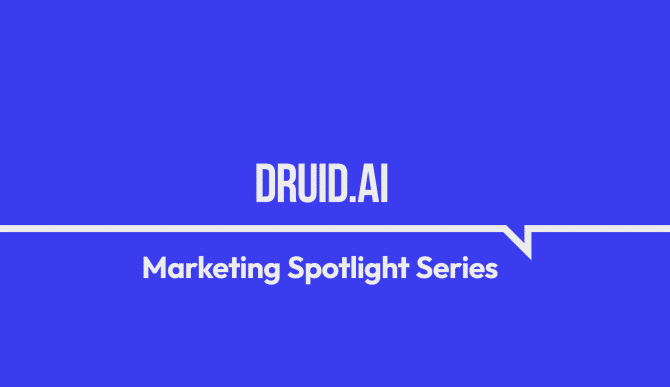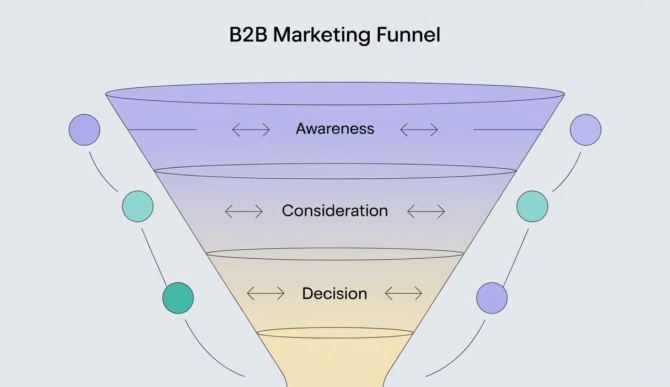Marketing Spotlight: How Palantir Markets Practical AI Without the Hype
Article summary
Share
Welcome back to Marketing Spotlight, where we analyze how tech brands communicate their value and what marketers like us can learn in the process. Today’s feature: Palantir Technologies.
Yes, that Palantir. The one with the mythical name, enterprise-grade AI platforms, and a client list that reads like a government secrets bingo card. But look past the black-box mystique, and what you’ll find is a company with a surprisingly grounded marketing approach, one that’s consistent, clear, and refreshingly non-flashy (for a company handling a lot of AI hype).
We’re unpacking how Palantir positions itself, builds a presence on social, and turns complex tech into demand as of October 2024. Whether you’re a B2B startup or a scale-up looking for smarter go-to-market moves, there’s plenty here to get inspired from, remix, and run with. (PS: If you need help, wink-wink, send us a message, we have Milk & Cookies and good strategies).
📝 A quick note before you start reading:
The data and analysis in this article are valid as of the time we wrote it. We don’t know when you’ll be reading this, maybe next week, maybe six months from now, and things might have changed since we looked at this company’s marketing and sales approach. Still, the insights and lessons here stay useful, even if the numbers or tactics have evolved a bit.
Grab a cookie. Let’s get into it.
Understanding the company
Palantir Technologies Inc. is a prominent American software company founded in 2003, primarily known for its advanced data analytics platforms.
They’ve made a name for themselves building tools that help organizations, from healthcare networks to national defense agencies, make sense of enormous amounts of data. Their specialities include data integration, big data, enterprise software, data analytics, data protection, and data engineering.
According to LinkedIn, Palantir employs ~4,200 people. The majority are engineers (around 1,800) and most are U.S.-based. That ratio alone tells you a lot about what they value most: technical depth over marketing polish.
Brand promise
Palantir doesn’t sell dashboards. It sells clarity in chaos, especially the kind found in massive, fractured datasets. Their core brand promise, “Get AI into operations,” is deceptively simple, and that’s precisely why it works.
At a glance, the phrase sounds like something you’d expect from any enterprise tech company trying to ride the AI wave. But Palantir uses it differently, not as hype, but as a frictionless entry point to a much bigger operational narrative.
This isn’t about theoretical AI or moonshot use cases. It’s about deploying machine intelligence to solve immediate, industry-specific problems. From hospital workflows to supply chain logistics, Palantir positions itself as the vendor that helps you actually do something with AI, without rebuilding your org from scratch.
Their homepage reinforces this promise with a rare kind of clarity for enterprise software:
“Our software lets our customers integrate and analyze all of their data so they can answer questions that they couldn’t before.”
The pitch is operational fluency, not digital reinvention.
Four platforms, one idea: usability = adoption
First, we start by saying that Palantir differentiates itself from its competitors through the capabilities of its platforms, highlighted in the section titled “What Makes Palantir Platforms Powerful.” You’ll find this prominently on their main page if you scroll down a bit. However, what sets them apart in terms of values and their way of thinking is a bit more hidden on the “About Us” page, meaning we have to search for it. Here, on the “About” page, we finally find their brand claim.
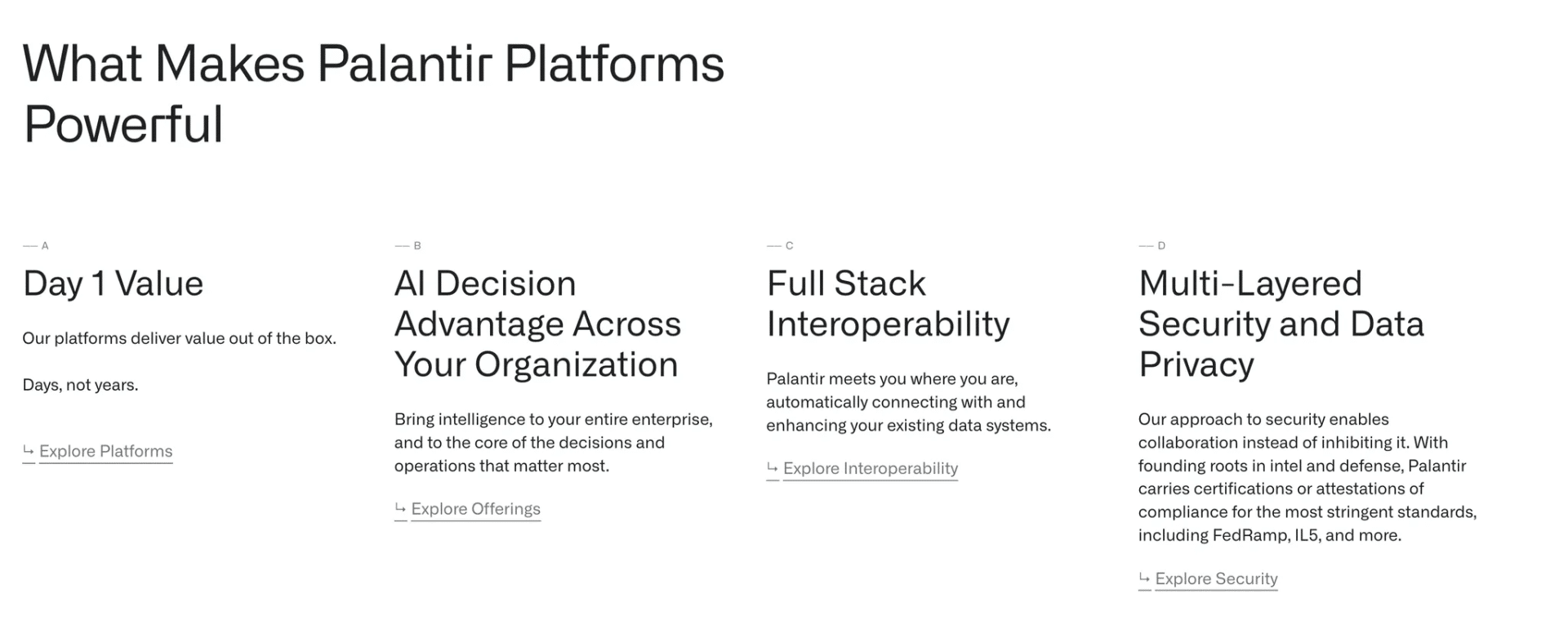
Palantir’s product ecosystem is built around four platforms:
- Foundry: Operational intelligence for commercial use
- Gotham: Originally built for government intelligence
- Apollo: Continuous delivery & deployment
- AIP (Artificial Intelligence Platform): Their newest launch, designed to help enterprises apply AI directly within their operations
All four platforms reinforce the same value: speed to insight, speed to deployment.
They’re not shy about it either. One of the boldest lines on their homepage reads: “Days, not years.”
That’s a positioning statement. Palantir is targeting the #1 frustration of any company stuck in digital transformation purgatory: speed. They want to be the anti-consultancy, the team that helps you build and launch without the two-year planning cycle.
Compatibility over conquest
Another big part of their value prop: they play nicely with existing systems. Palantir doesn’t require you to migrate your entire data stack or reinvent your workflow from the ground up. They meet your data “where it lives,” as they say, offering integration-first solutions that reduce adoption barriers.
This is smart positioning in an industry littered with tools that promise magic but require a forklift to install. It also aligns with their reputation: serious tech, serious impact, minimal fluff.
A brand built on engineers (not academics)
Palantir is obsessed with one thing: building software that solves actual problems. And they’ve baked that mindset into their brand voice.
Their “About Us” page includes a handful of surprisingly human (and refreshingly non-corporate) lines that clarify their philosophy. For example:
- “We believe in augmenting human intelligence, not replacing it.”
- “We build our company around mission-driven engineering.”
- “We meet the problems where they live.”
The standout? “We’re engineers, not academics.”
That single line does a lot of work. It distances Palantir from ivory-tower AI theorists and vague consulting-speak. It positions them as builders, people who understand real-world constraints and work within them, not above them.
In short: their differentiation isn’t only in what they sell, it’s in how they think.
They’re saying, “We’re not here to pitch AI as magic. We’re here to make it work for your org, right now, with the data you already have.”
That’s a clear message in an industry still full of jargon-heavy “transformation” talk. It also makes their platforms easier to trust, especially for enterprise buyers looking for real-world results, not philosophical debates.

How do they approach social media
LinkedIn is the primary stage of Palantir
If there’s one social platform where Palantir shows up with intent, it’s LinkedIn.
With 350K+ followers and a healthy average of 30 posts per month, this isn’t a place populated by automated content. It’s a deliberate, high-frequency channel for visibility, thought leadership, and lead nurturing, all with a professional face.
And it is a face. Often, the CEO or CTO steps in front of the camera to explain platform features, talk shop about AI, or casually walk through enterprise use cases. The tone? Conversational but focused, like a TED Talk if the speaker actually used the product.
Their LinkedIn “About Us” section is straightforward and friendly. Their goal is clear: “helping the world’s most important institutions use their data to solve their most urgent problems.” The phrase “Together with our customers” highlights their collaborative approach, positioning themselves as partners rather than mere service providers.
The Median Employee Tenure is 2.7 years and it might suggest a relatively stable workforce, although it may also indicate some turnover.

What they post (and what they skip)
Palantir leans heavily on:
- Product releases and feature announcements (like “Visual Navigation (VNav)” for drones)
- Thought-leadership soundbites from executives
- Partnership wins and big client case studies featuring important voices discussing the benefits of adopting A
- Webinars, events, and calls to action
You’ll see a lot of video + text, and sometimes image + text. What you won’t see? Carousels, polls, or much interactive content. It’s clear Palantir is using LinkedIn as a broadcast channel, not a two-way street.
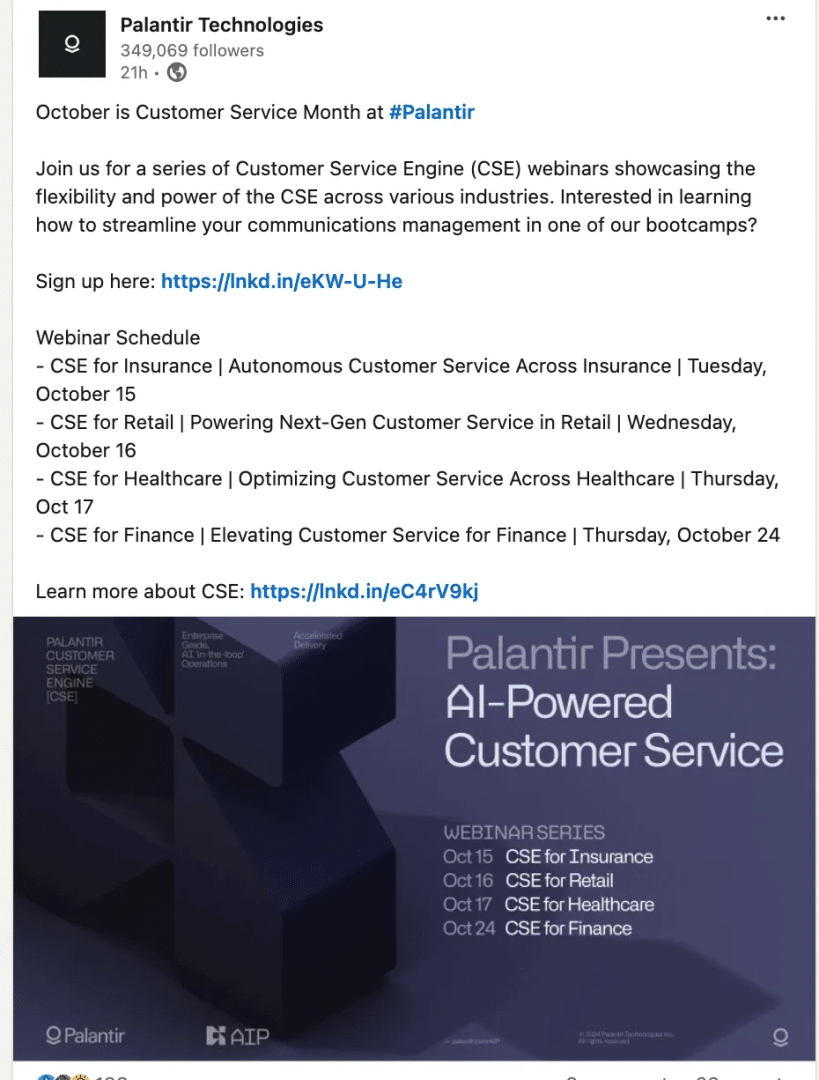
Their LinkedIn posts include a call-to-action (CTA) button, such as “learn more,” followed by a link that directs leads to their webpage or their blog page on Medium.
For example, we can see that for their Visual Navigation (VNav) they have used the title “The future of drone navigation”. From a marketing perspective, the scope might be positioning their VNav as an innovative solution that is changing the future and how drones are operated and used.
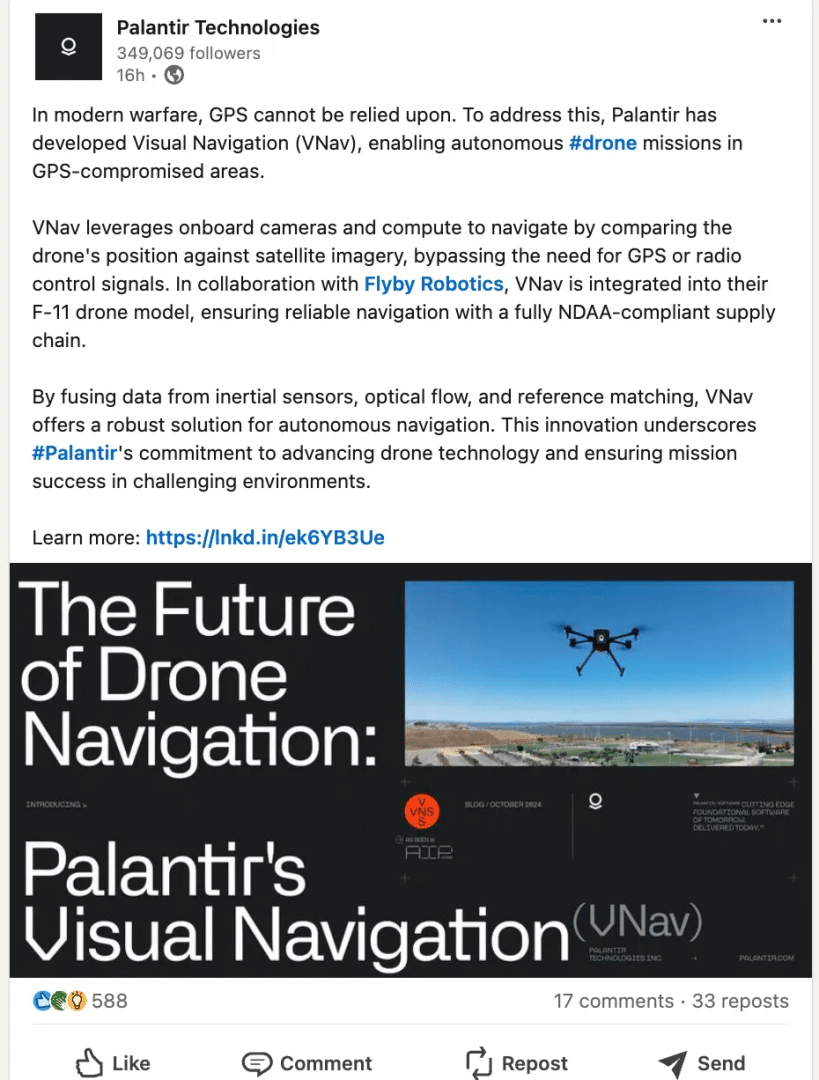
They also used lots of videos (they are more engaging than text-based content, that’s for sure). For example, they have many videos featuring the CTO or CEO explaining concepts or delivering speeches on relevant topics. What could this mean? Human connection: Featuring a company executive can help create a more personal bond with the audience, making the brand more relatable. They also use their videos to demonstrate how their platform works and how to utilize AI. For instance, there is a video featuring Chad Wahlquist from Palantir showcasing how to use AI agents within an enterprise context.

We can also see that they announce partnerships, such as the one with NHS England’s Federated Data Platform (FDP). These posts position Palantir as a great service provider in solving healthcare problems & needs (but of course, it works for any industry).
They share case studies, where they invite readers to do an action, such as “Read Part 1 now”, hoping to encourage immediate engagement. However, it’s worth noting that the case study links to Medium rather than Palantir’s own blog page. This could dilute brand identity if they are directing traffic away from their site. From a marketing perspective, it’s generally better to drive traffic to owned channels where users can explore the brand and its offerings, find CTA, or even talk to a bot.
We also appreciate their use of videos to highlight what sets Palantir apart. For instance, they featured a casual conversation between the CEO and one of their University Fellows students. These types of posts not only showcase the company’s culture and values but can also serve as a call to action, encouraging people to join the Palantir team.

Palantir also uses LinkedIn to introduce new features, such as “Build with AIP.” While they don’t focus heavily on educating their audience about data and AI, they do showcase their capabilities.
Despite their steady output, Palantir doesn’t reply to comments or interact much with their audience. For a company with technical depth and a clear voice, it feels like a missed opportunity to build stronger community ties.
The upside is brand control. The downside? A colder, less connected presence, more podium than conversation.
LinkedIn Newsletter
Palantir has a LinkedIn newsletter with 55K subscribers and six editions focused on building and delivering operational AI. However, they are not publishing it following a clear schedule. There have been some wide time gaps between the 8 editions so far. While they use the company-specific hashtag #Palantir, they also rely on more generic hashtags like #software, which can help increase visibility.

CTAs that match the moment
Palantir is strategic with its **calls to action:**s
- “Join the Palantir team”
- “Learn more about Irina’s contribution to the development of AIP”
- “Sign up here: https://lnkd.in/eKW-U-He” (for webinars)
- “Learn more: https://lnkd.in/ek6YB3Ue” (for VNav)
- “Read Part 1 now and see how AI can transform your customer experience: https://lnkd.in/erzX-vZg“
- “Enter to win the chance to join us at DevCon: https://lnkd.in/gAaWizeb“
Curious about the best performing posts? Here are three of them.
Why is that? Well, for the first one, the CEO is giving a speech. But more importantly, it’s the message he’s conveying: his team (partners) are incredibly committed to their work and make it their top priority.
For the second one, the post positions Palantir as an alternative to traditional ERP systems, claiming it can do more in less time. In the 3rd one, they are announcing their Q2 Revenue.


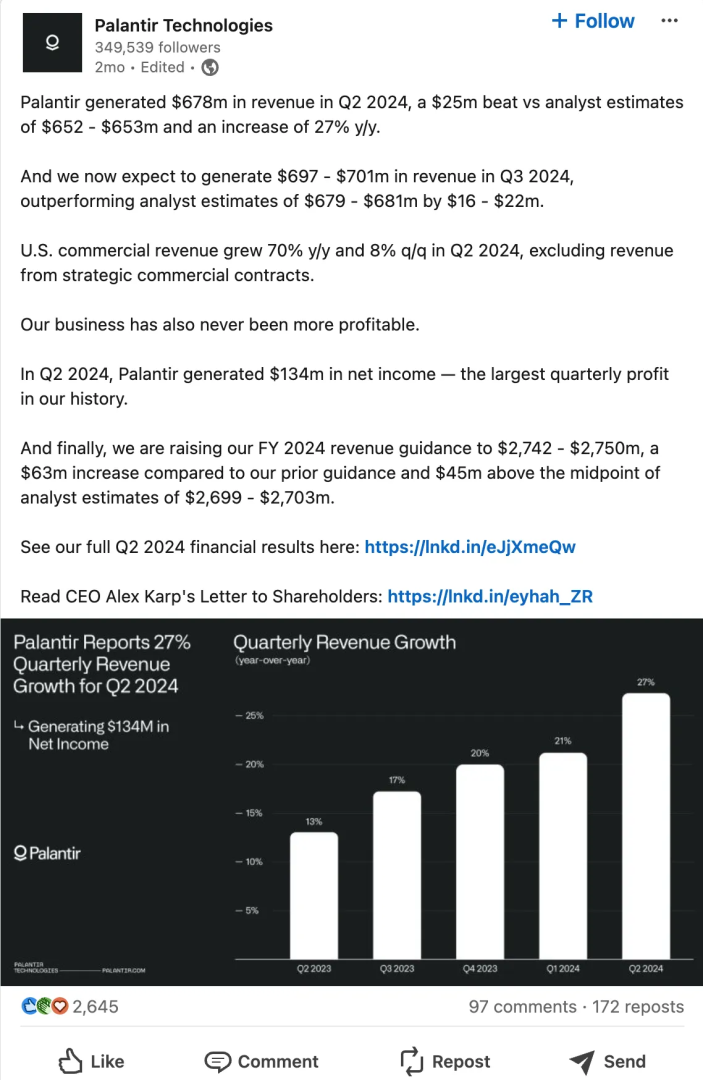
LinkedIn Job openings
Palantir Technologies has 210 job openings on LinkedIn. We went through their jobs and we saw some interesting facts.
- Positions “Capture and Proposal Strategist” and “Account Executive” might suggest that they are focusing on acquiring new customers and expanding existing relationships.
- Roles like “Site Reliability Engineer” and “Incident Management Engineer” are meant to make sure the reliability of Palantir’s platforms.
A supporting cast of channels beyond LinkedIn
X / Twitter

On X they have 195K followers and they post every week, even more times a week. However, their content here is not exactly unique, it is recycled (it is a common practice). When it comes to engagement, we can say it is relatively modest compared to the number of followers; and the viewership is quite diverse, from 14K to 236K depending on the subject, but in general it is around 25K.
Palantir on YouTube

Youtube is where the brand breathes a little more.
Palantir’s YouTube channel has 85K subscribers and nearly 300 videos, ranging from product explainers to fireside chats with the CEO. It’s not always consistent in posting cadence, but it’s a solid content bank that blends platform capabilities, culture, and event coverage.
They’ve clearly figured out that video is the best way to unpack complex tech, and when it’s done well, it doesn’t just inform, it builds trust. For B2B brands in the AI space, that’s half the battle.
Github
Palantir’s GitHub page shows that they’re open and transparent about their work. This can help people trust them more, as they can see the code and tools the company builds. This could make them look even better as a reliable tech provider.

Social media strategy analysis
A few patterns emerge across their social presence:
- Heavy video use, especially on LinkedIn and YouTube, showing the product, explaining the tech, or letting execs put a face to the brand
- A clear content hierarchy: LinkedIn = primary channel; Twitter/X = distribution; YouTube = education and storytelling
- Minimal audience interaction, suggesting a top-down content model vs. community-led one
- A consistent brand message throughout: AI that works in the real world
There’s a calculated professionalism to how Palantir handles its social footprint. It’s not playful. It’s not especially warm. But it is incredibly consistent, and in a category as crowded as enterprise AI, that counts for a lot.
Palantir’s blog is hosted on Medium. Perhaps they chose this platform because publishing on Medium allows them to reach a broader audience. Medium has strong domain authority, which can help Palantir’s content rank higher in search engine results. This increases the chances of new prospects discovering their articles and, by extension, their solutions.
As a guess, Palantir’s primary focus on LinkedIn may not necessarily be to drive traffic to their website but rather to sustain and reinforce their leadership position.
Palantir’s demand generation machine
Palantir’s approach to demand generation isn’t loud or lead-gen-forward in the traditional sense. There are no splashy landing pages shouting for your email, no overused popups begging you to download a “state of AI” report. Instead, they play the long game, leading with depth, authority, and a clear bias for usefulness.
And they do this across a handful of smartly positioned content assets: a technical blog (hosted on Medium), an open community forum, a training portal, and industry-specific impact studies.
Palantir’s blog
Palantir publishes regularly. They post a new article every week, although this consistency only starting July 2024.
But they’ve chosen Medium as their primary blogging platform, not their own website.
There’s logic here. Medium gives them baked-in distribution, SEO power, and reach beyond their immediate audience. It’s a quick way to share expertise with a wider tech-minded crowd without maintaining a full-blown CMS.
But here’s the tradeoff:
They’re giving up first-party data, search behavior, and conversion control. No embedded lead forms. No strategic CTAs. No newsletter popups. And more importantly, they’re training their audience to interact with Medium, not Palantir.com.
If you’re a startup or growing B2B company, here’s a clear line to draw:
🧠 If you’re testing content or publishing casually, Medium’s fine. But if you’re serious about building a scalable marketing engine, your blog needs to live on your own domain.
That’s how you turn readers into leads and leads into conversations.
Most of Palantir’s blog content is long-form, think ~3,000 words, and written in an approachable but technical tone. Their audience clearly isn’t beginners. The writing assumes a baseline understanding of AI, data architecture, or engineering practices.
But what’s refreshing is that it never talks down. There’s zero jargon-for-jargon’s-sake, and that accessibility builds trust.
Topic-wise, there’s a solid mix of:
- Technical deep dives (especially around Foundry)
- Responsible AI principles
- Employee voices and internal culture highlights
- Customer collaboration stories
In short: it’s not product marketing. It’s capability marketing and it’s done with restraint.
Since it is not their website, we don’t see any CTA buttons; however, at the end of the articles, there are some CTAs inviting leads to take action. This is not the case for every article, as some do not include any CTAs.

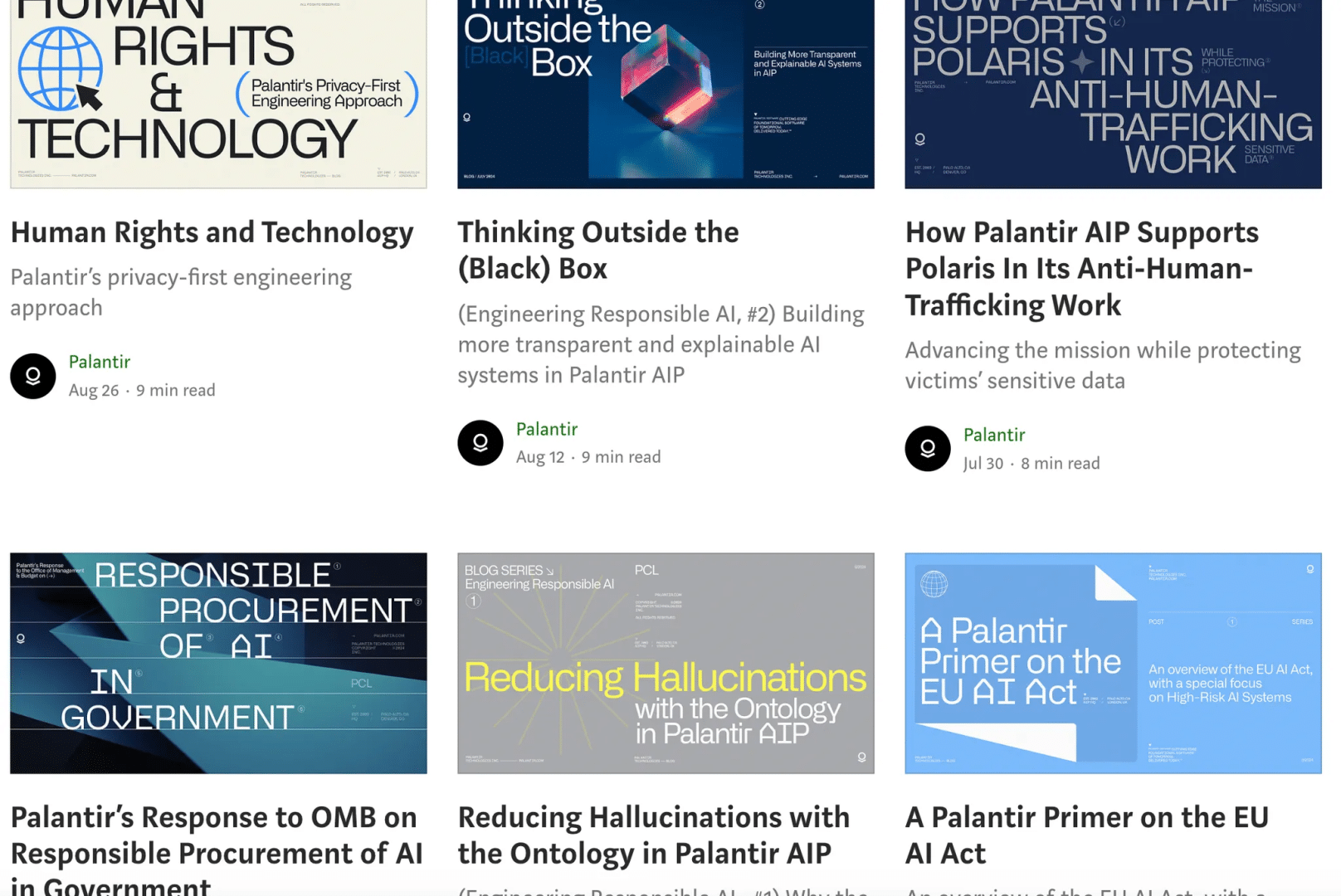
Also, posts like “Palantir Mentors Help College Students Tackle Climate Resiliency Challenge” might show the company’s commitment to social responsibility and employee engagement. A large section of this blog is also dedicated to their Foundry Platform.
Overall Impression: technical expertise and commitment to responsible AI development seem to be the most common type of blog posts. The blog is here to reach to a technical audience, including data scientists, engineers, and AI researchers. This blog page position Palantir as a thought leader in AI and data management.
Developer community
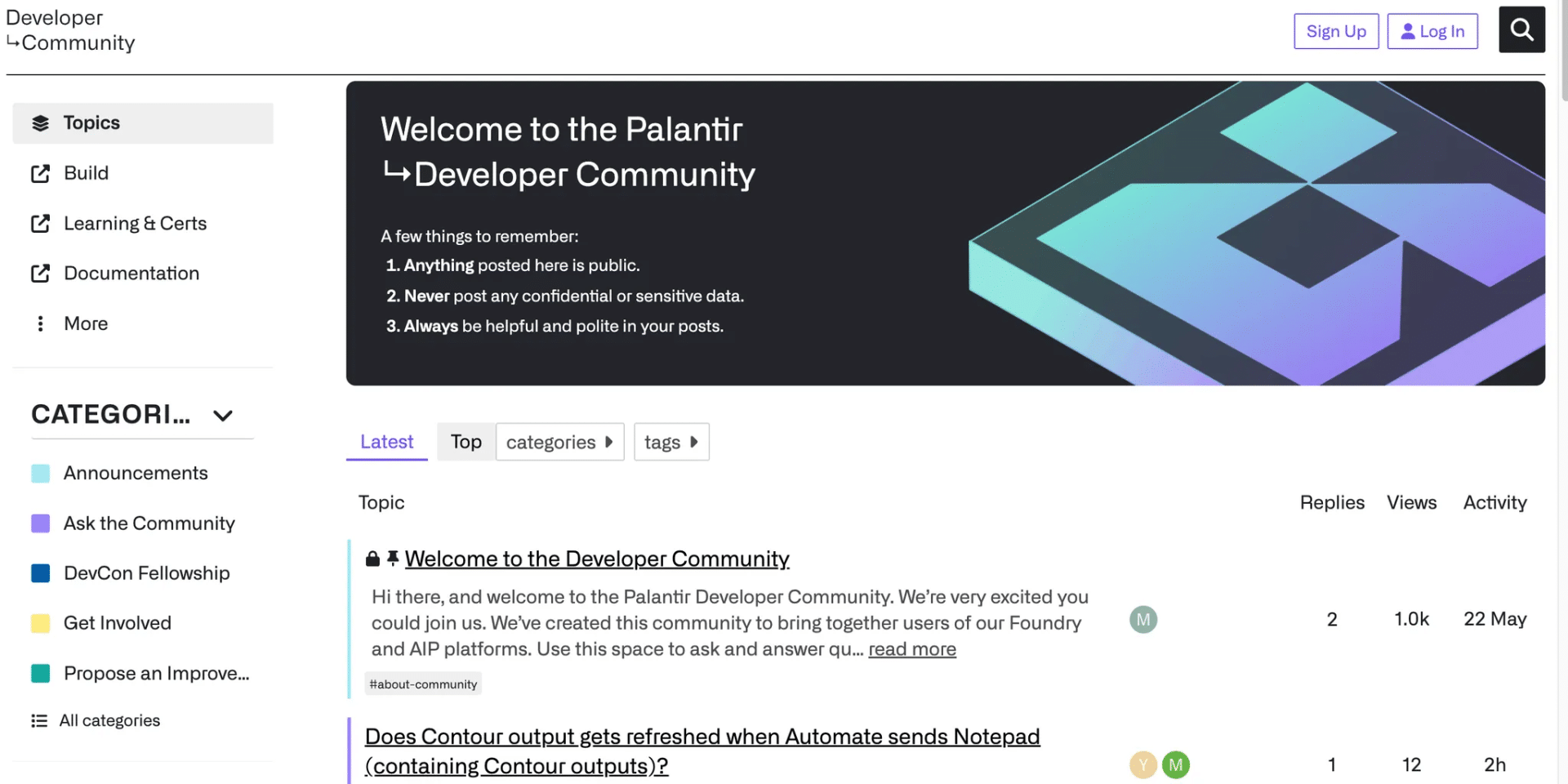
Palantir’s developer community forum is a hidden gem. It’s designed like a good product should be: no-nonsense, organized, and focused on real problems. Here they provide learning opportunities, including courses and certificates. Like any other community, people can ask questions and receive replies from others. The forum is organized into categories such as “Build,” “Learning & Certs,” and “Documentation” to help users find what they need.
Users can view the most recent and popular discussions. What we appreciated here were the guidelines designed to ensure respectful and helpful interactions.
Moreover, the community can be a valuable source for social listening. Community members are likely to share their thoughts, opinions, and experiences with Palantir’s products and services directly on the forum. Palantir could check the discussions and topics within its community forums to gain insights into user pain points and product improvement opportunities.
The learn portal aka the resources center
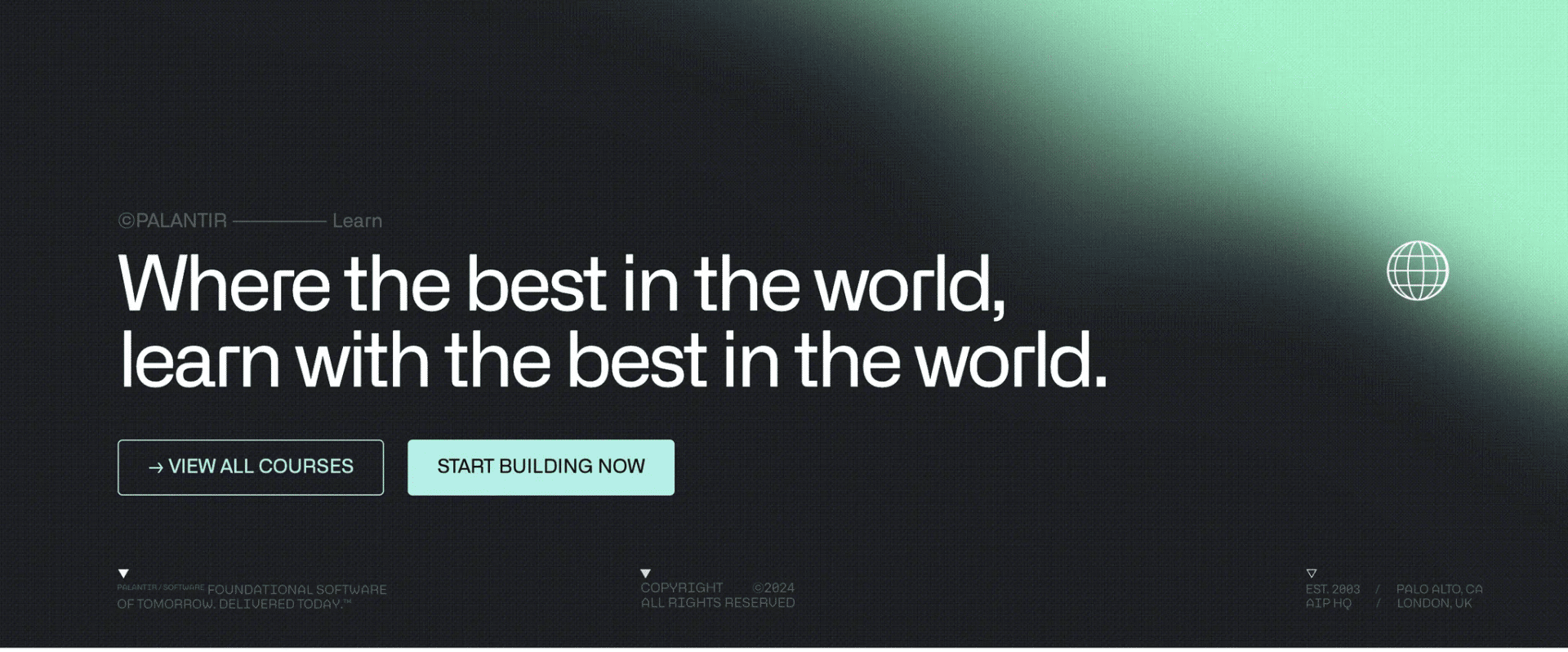
In terms of content marketing they feature “impact studies”, showing how their platforms are used by different companies from different industries.
For example:
“Using Palantir Foundry to integrate data from across their different titles and revenue streams, Axel Springer has built a more agile, data-driven publishing organization that can quickly adapt and respond to trends in consumer behaviors and interests”.
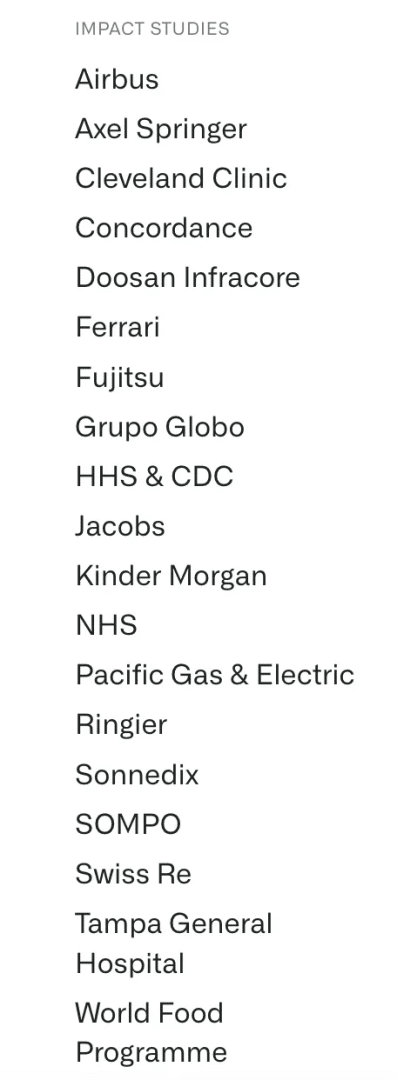
There is great Learn section on their website. The tagline “Where the best in the world, learn with the best in the world” suggests that Palantir’s courses are taught by highly skilled and experienced instructors. Of course, it seems that Palantir’s courses are primarily focused on their Foundry platform. The courses explicitly mention “Foundry” and require access to the platform “Get started learning Foundry with the Speedrun”. They want to teach people to use their platform. This is not surprising.
Their courses target the following leads: “Data Engineer,” “Application Developer,” “AI Engineer,” “Dana analyst”. suggesting that Palantir offers specialized training tailored to different roles within the data and technology field.
Case Studies, Impact Pages, and Real-World Proof
This is where things get more emotionally persuasive. Palantir doesn’t rely on abstract outcomes — they show what their platforms actually do inside real organizations.
Their Impact Studies spotlight recognizable brands across healthcare, media, and logistics. Example: Axel Springer using Foundry to unify revenue streams and make publishing more agile.
These aren’t glossy PR pieces. They’re straightforward, operations-focused snapshots — the kind of proof points that matter most to enterprise buyers.
Newsletter
Their newsletter is not publicly displayed on their website. We found it through their announcements. The newsletter is tied to the foundry user account. “Newsletters and other content shared through these opt-in subscriptions will be sent to the email address associated with the Foundry user account.”
To subscribe to the newsletter, leads have to follow some steps:
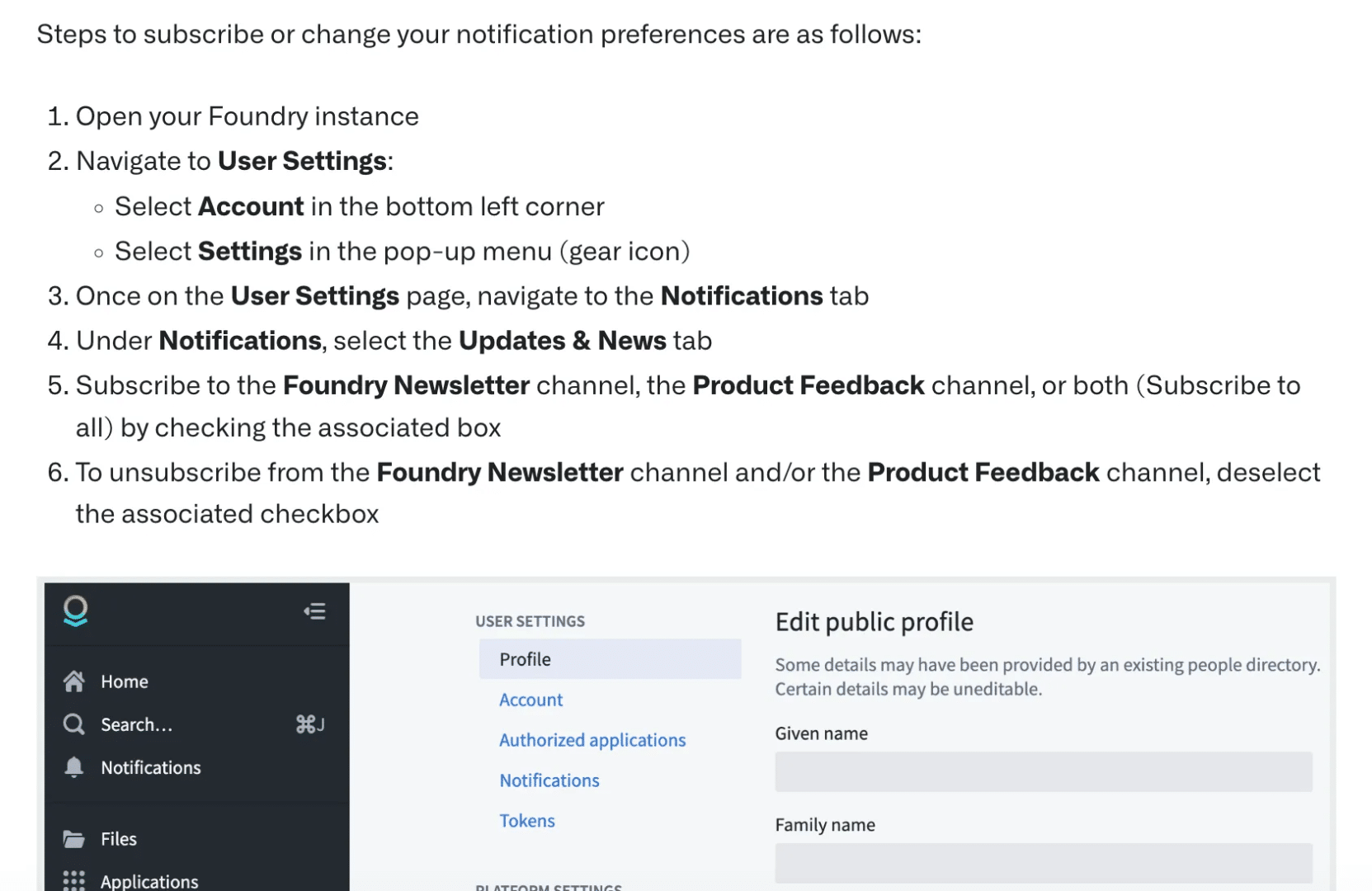
The newsletter seems designed for users who have opted in through their Foundry accounts. This makes sure that only those who are actively using the platform receive updates – a more targeted and relevant communication strategy.
But, on the other hand, we found something which looks like a “general newsletter” on the Apollo platform. It’s quite interesting to see the newsletter registration there!
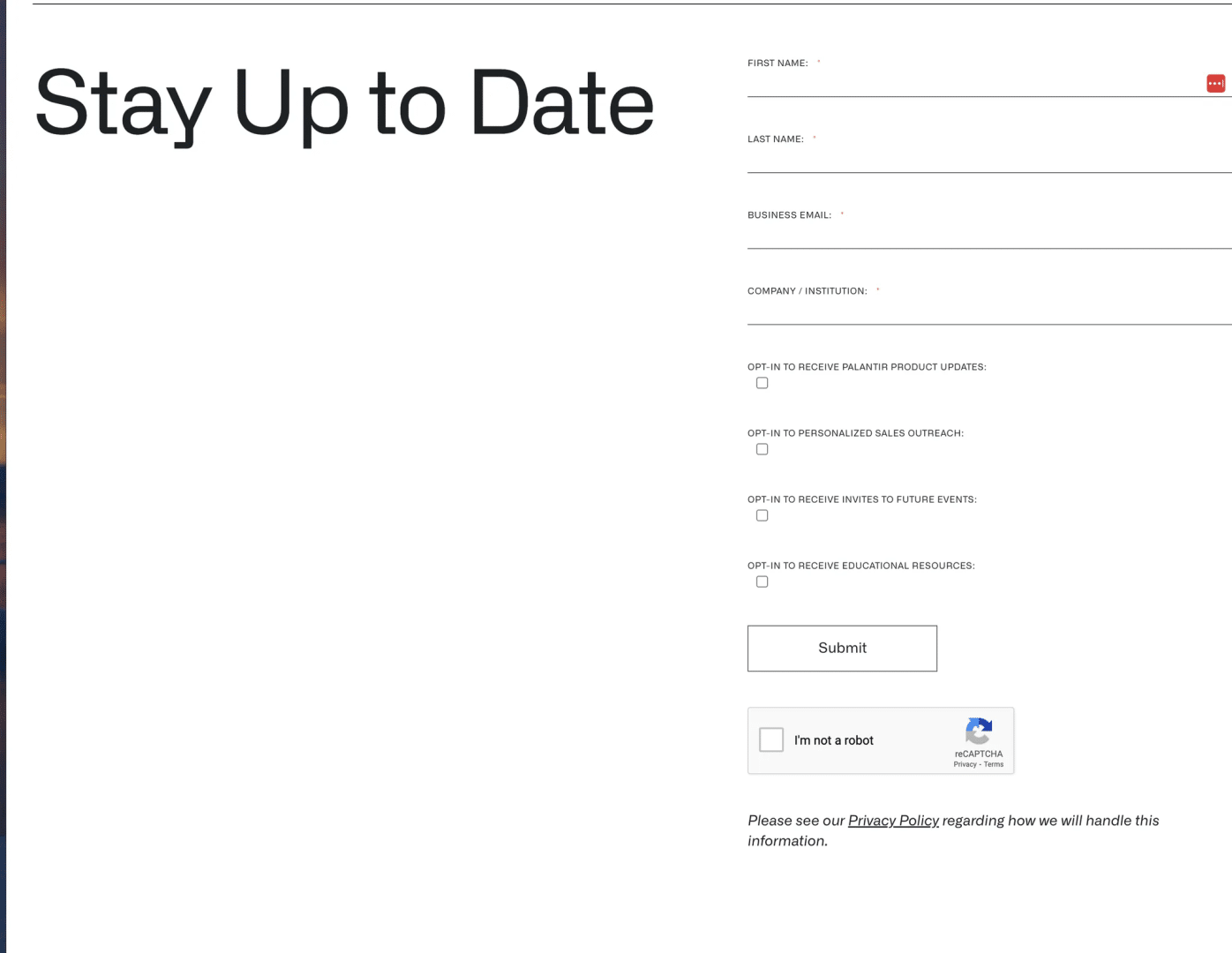
The bottom line
Palantir’s demand generation strategy targets leading institutions and organizations across various industries. And how do they do this? Their approach is creating content that shows how other organizations within the same industry have adopted their solutions (basically by showing partnerships and case studies). They put a lot of focus on responsible AI, which is particularly relevant given Palantir’s role in the industry and its immense responsibility when handling data.
If we were to describe Palantir’s profile, we would characterize as very professional. For example, the articles are lengthy and detailed, which suggests that Palantir values in-depth knowledge sharing and aims to provide substantial insights rather than superficial content. They create diverse types of content (blog posts, newsletters, learning center resources) to attract their target audience, with most of their blog content written for advanced readers rather than beginners, assuming a certain level of existing knowledge.
Palantir’s lead generation machine with quiet funnels, smart touchpoints
Palantir isn’t chasing leads in the traditional B2B sense. There’s no aggressive “Download Now!” energy. No chatbot pop-ups crowding the screen. No lead-gen jungle of gated content, ebooks, or nurture sequences. But that doesn’t mean they’re not building a funnel — they’re just doing it on their own terms.
If anything, their lead generation strategy mirrors their product philosophy: subtle, streamlined, and built for users who already know what they need.
Here’s what it looks like in the wild.
Landing pages
Palantir keeps its conversion points few, but focused. Let’s look at the key ones:
- “Get Started” Page: This page is designed for general inquiries and serves multiple purposes:
- Contact requests
- Demo requests
- Partnership inquiries
The page is intentionally simple, featuring a straightforward form with a single submit button to reduce friction and encourage user engagement.
- AIP Bootcamp Signup This landing page invites users to schedule a seat in one of Palantir’s “zero to use-case in 5 days” bootcamps. This is one of the smartest offers on the site. It’s essentially a hands-on proof of value, perfect for buyers who want to see before they sign. The promise of fast results (“5 days”) is baked right into the CTA, lowering the barrier to trial. Do we know if it’s free? Not quite. And that might cause friction. Transparency on this could help convert more curious visitors into participants.
- Whitepaper Downloads Palantir also offers gated content like this Apollo whitepaper. Users have to submit a business email to access it, a smart filtering move to target enterprise-level leads, not casual browsers or Gmail accounts. Unlike many companies that gate lightweight fluff, Palantir seems to reserve this tactic for truly strategic content. Good instinct.
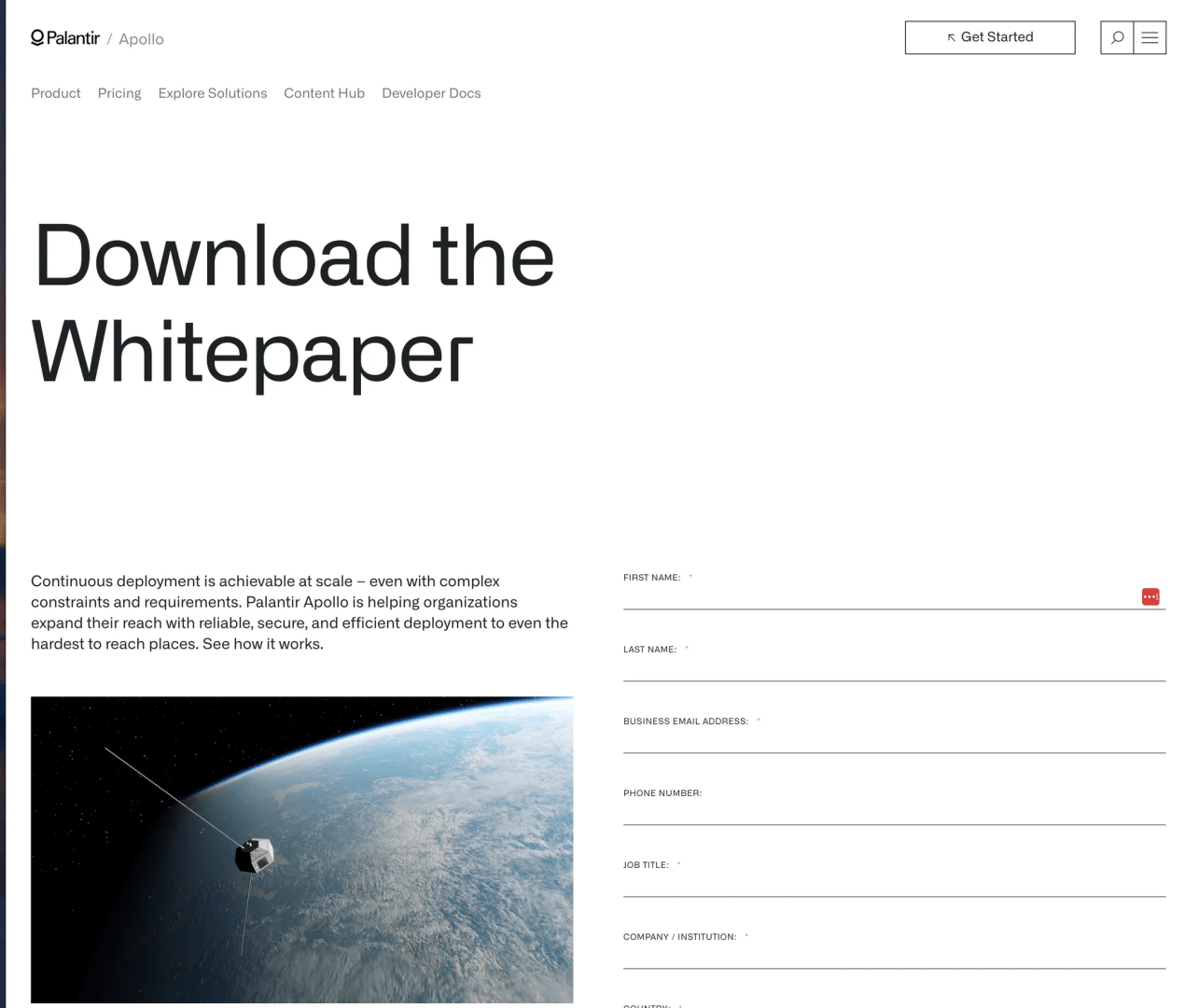
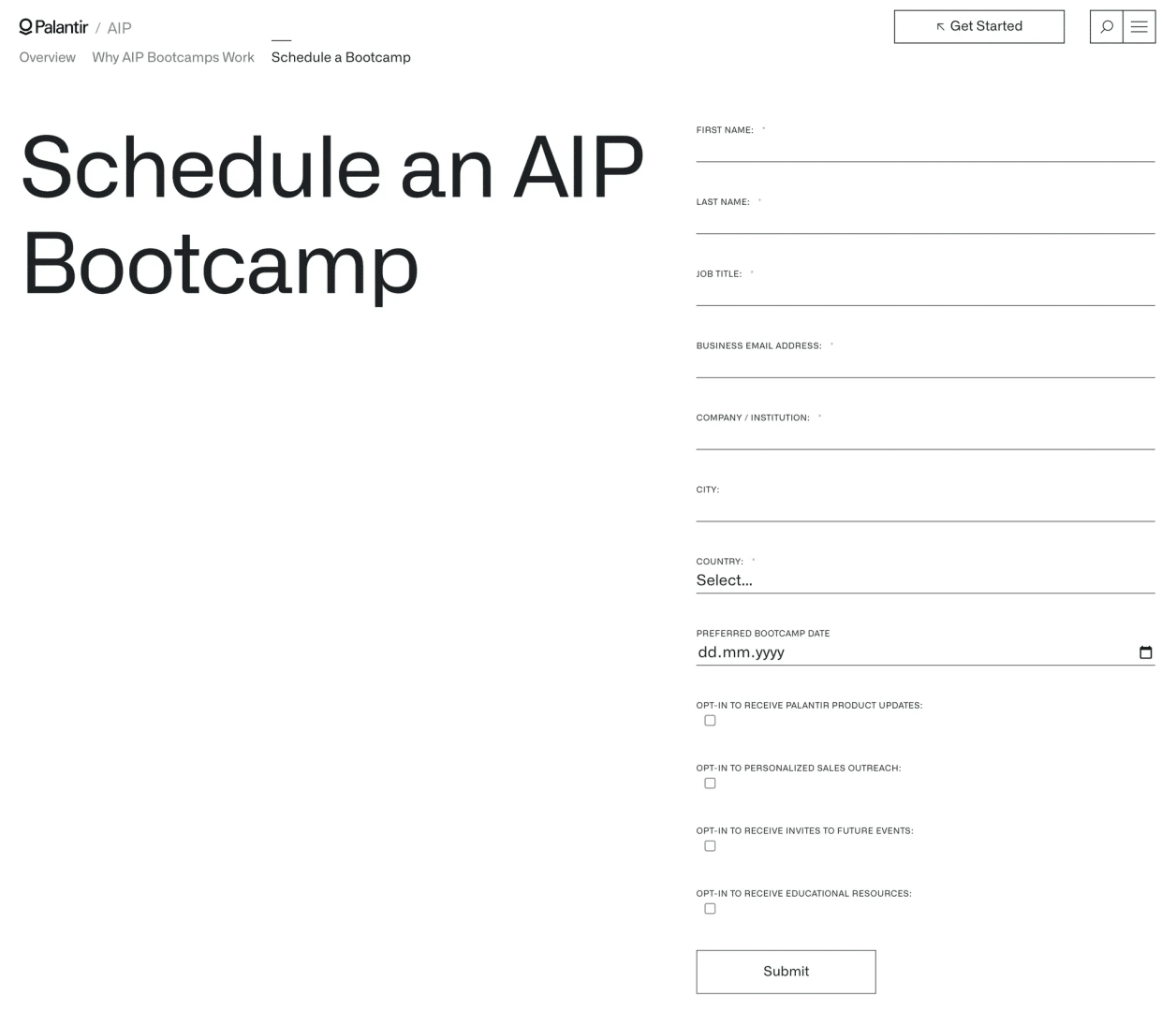
CTA strategy
Throughout the site and social channels, Palantir sticks to a small set of focused calls to action:
- “Get Started”
- “Schedule a Bootcamp”
- “Explore Platforms”
- “Download Whitepaper”
- “Join the Palantir team”
- “Read Part 1 now” (for Medium articles)
- “Sign up here” (for webinars or events)
None of these try to be clever. And that’s a good thing. Clarity beats creativity in conversion.
Interestingly, they don’t use inline CTAs or sticky banners. Their ask is never pushy. Which, depending on your audience, could be either elegantly respectful… or a bit too passive. For early-stage B2B companies, being subtle might cost you valuable leads.

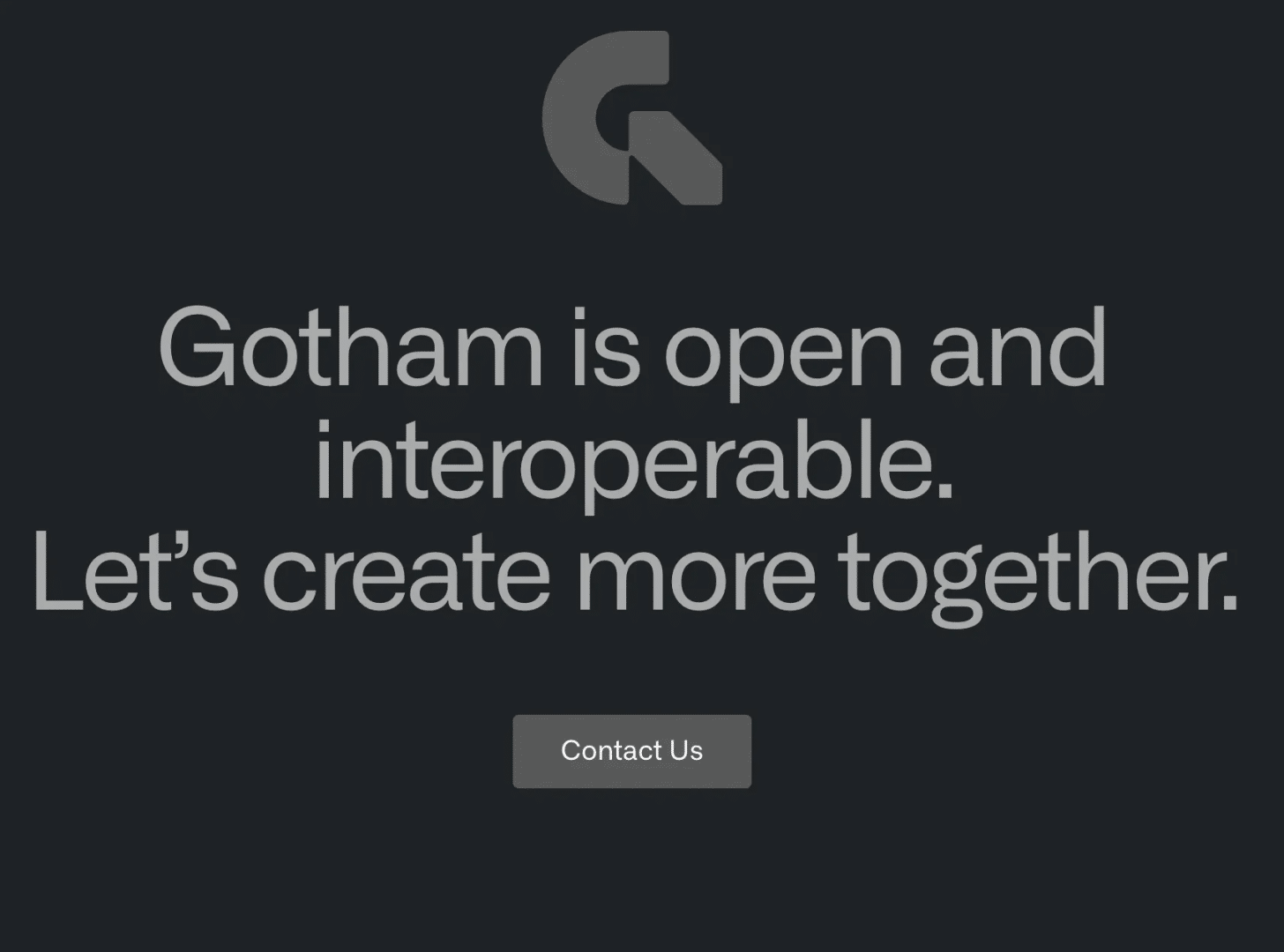
Palantir marketing: Downloadable & gated content
As we have mentioned before, Palantir has white-paper for which user have to input their business email address. The white paper likely contains information that is primarily relevant to businesses and professionals. Also, they might request a business email to reach only qualified leads, companies not individuals.
Webinars
Palantir promotes live webinars and events like AIPCon via LinkedIn. Signup is usually frictionless, just an email address. But there’s no central webinar hub on their website, which means discoverability is low unless you’re following them closely on social.
Again, that’s fine for a brand with awareness. But if you’re not Palantir, and your audience isn’t checking your LinkedIn daily, make your events easier to find and rewatch.
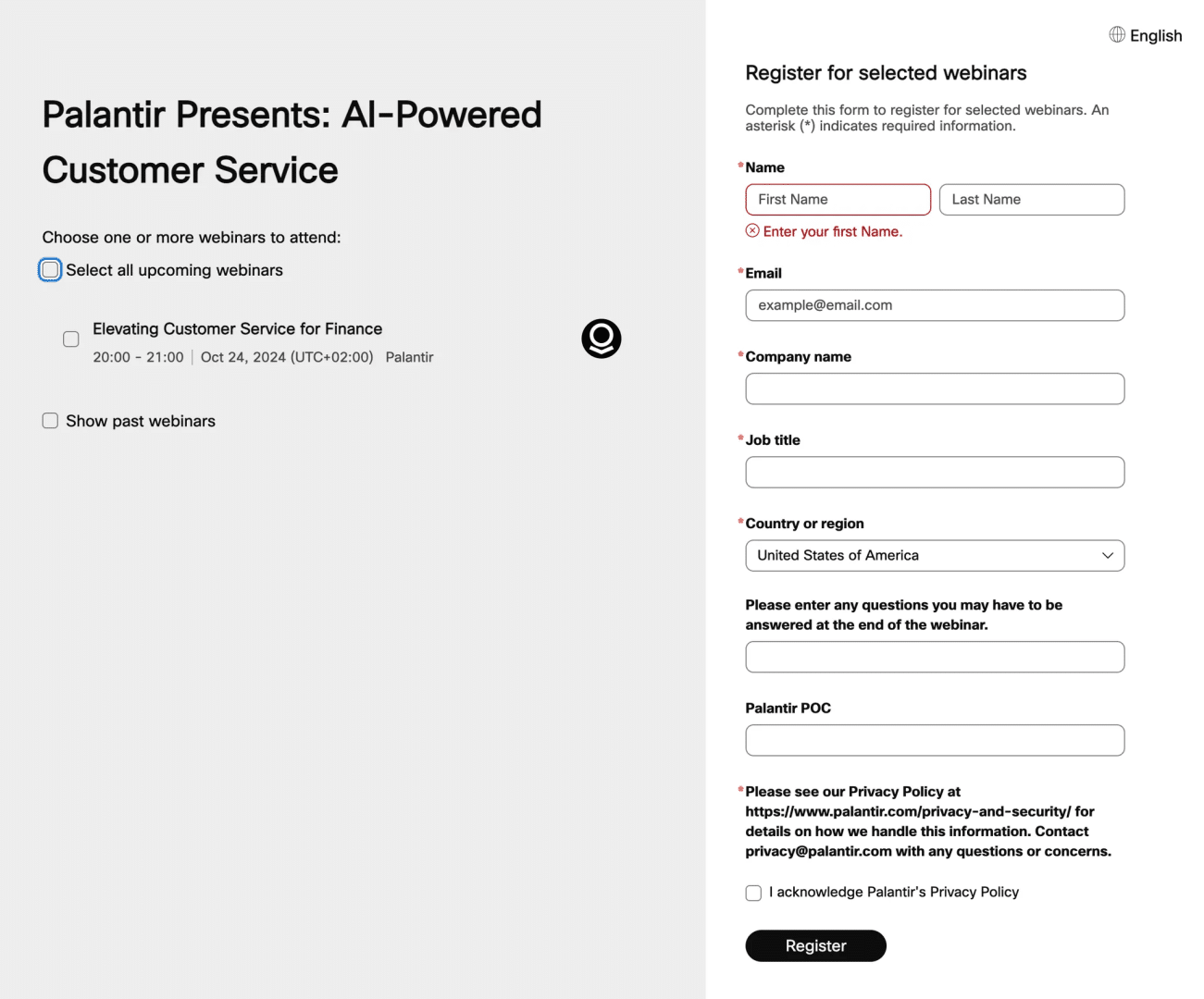
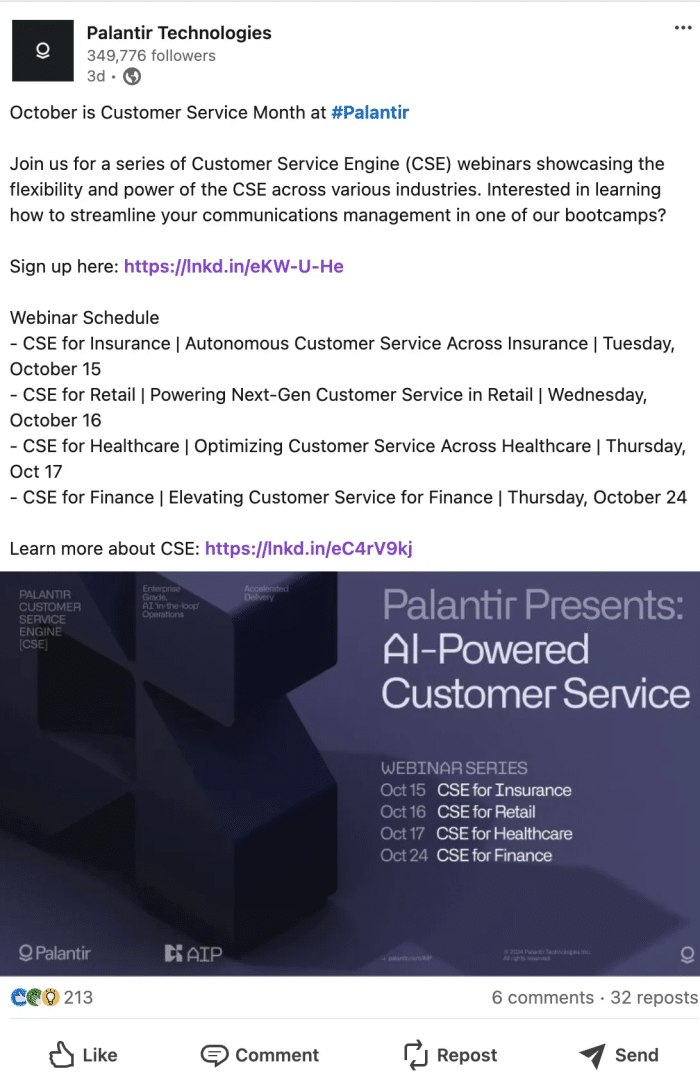
Paid ads
In October 2024 Palantir had 116 ads on LinkedIn. Most of them follow a consistent format:
- Short videos that demo product features or executive soundbites
- Headlines that emphasize action: “Build with AIP”, “From zero to use-case”, “See how it works”
- CTAs that link out to YouTube or Palantir.com
They’re not promoting ebooks or gated content. No spammy “Download our checklist” ads. Their paid strategy sticks to high-quality, high-intent content, like product explainers and keynote footage. Smart move for a complex platform that needs more than a banner to convince.
Notably, they promoted their S&P 500 inclusion. But they rarely advertise traditional case studies or whitepapers.
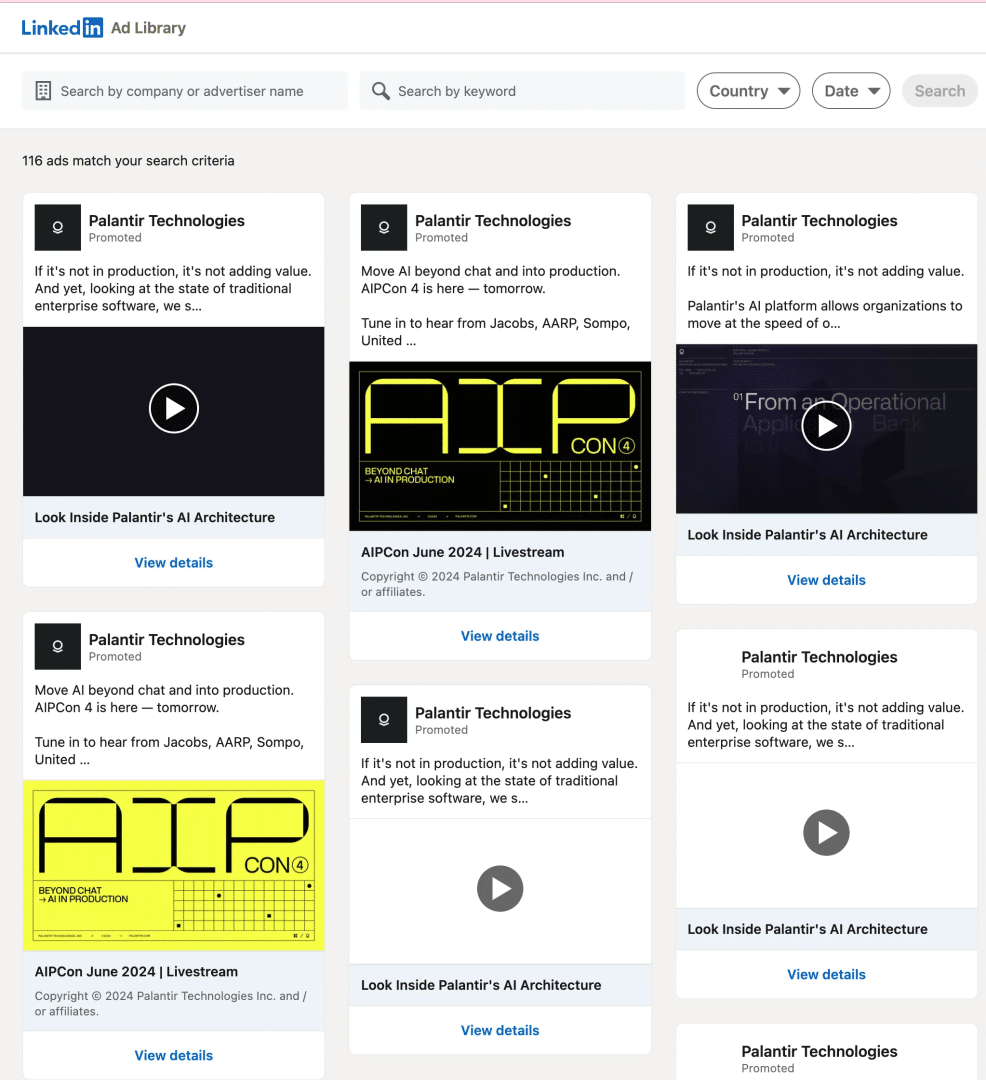
What’s missing (and why it matters)
A few gaps worth noting:
- Newsletter visibility is weirdly buried. It only appears after logging into a Foundry user account, or deep inside the Apollo product page. If Palantir wants to build an email-first relationship with users, this needs to live front and center on the site.
- No nurture strategy is visible. We don’t know what happens after someone downloads a whitepaper or signs up for a bootcamp. Are there automated follow-ups? Is there a journey in place? Maybe — but nothing signals that clearly.
- No blog-based lead capture. As covered earlier, all blog traffic goes to Medium. And Medium doesn’t belong to Palantir — meaning they lose out on tracking, personalization, and conversion control.
If you’re building your own lead gen stack, here’s your TL;DR:
📩 Keep your best content on your site. Give it a home, surround it with CTAs, and make it work for your funnel.
What smart tech marketers can learn from Palantir
Palantir doesn’t rely on charm or splashy slogans to win attention. Their marketing strategy is unapologetically practical — built for decision-makers who care more about solving problems than reading poetry.
And that’s exactly what makes their approach worth studying.
What that get right
- Consistent brand messaging across every channel, anchored in one clear promise: “Get AI into operations”
- Deep, technical content that speaks to experienced buyers without watering anything down
- Executive visibility that adds both authority and relatability (especially via video)
- Real-world proof through case studies and industry-specific content
- Clear POV: They don’t try to be everything to everyone — they know who they’re for
- LinkedIn as the mothership of engagement and amplification
- Minimalist, high-impact conversion paths: no noise, just focused next steps
- Community and learning hubs to educate, support, and listen — not just sell
- Strategic use of Medium, YouTube, and GitHub to serve specific audiences with the right format
What inspired us:
- DevCon Fellowship: DevCon is an invite-only accelerator event bringing together 150 of the most ambitious builders for two days of workshops, showcases, and competition. This could be a way to identify and attract top emerging talent in the field. It could also boost the company’s reputation as an innovator and educator: “At Palantir, we learn by doing. That’s why we’re launching the DevCon Fellowship.” More than that, from a CSR point of view, the fellowship can be seen as part of Palantir’s efforts to contribute to tech education and skill development.
- Palantir has a thought leadership page on their website that serves as a hub for sharing insights and expertise. This page is organized into different categories, focusing on specific industries like health and life sciences, commercial sectors, and defense. The page features key moments from Palantir’s events, such as AIPCon (Artificial Intelligence Platform Conference). These often include snippets or highlights of speeches, particularly from notable figures like Palantir’s CEO. Many of the featured talks or interviews are linked to Palantir’s YouTube channel, where visitors can watch full videos or extended clips. Some content links out to interviews or articles published on external media sites or PR platforms.
- Palantir’s store: It was surprising to see that they have a store, where they sell their merchandise. The merchandise might seem to be dedicated not only to Palantir employees but also to fans and supporters of the company. This includes tech enthusiasts, investors, and individuals interested in AI and data analytics. The idea? Create a sense of community among its users and supporters.
How you can apply this to your tech marketing strategy
Let’s take this from observation to action. Here’s what Palantir’s strategy should make you think about:
1. Start with a POV, not a product
Palantir leads with a worldview: that AI should be usable, fast to deploy, and operationally meaningful. This frames everything else.
Ask yourself: What belief or principle guides your messaging? If your answer is “we’re flexible,” you don’t have one yet.
2. Get your executives on camera
No, not a stiff keynote. Think human-first, real-talk content:
- 3-min clips explaining product choices
- Internal Q&A-style videos
- Founder AMA-style sessions
It builds authority, creates connection, and sticks. In B2B, people trust people more than brands. Especially when the stakes are high.
3. Make your content worth the scroll
If your blog posts are light and vague, your leads will be too.
Palantir’s content succeeds because it’s:
- Long-form, but not bloated
- Specific, not self-congratulatory
- Built for someone, not everyone
Pro tip: Speak to the 10% of your market that really gets it and you’ll attract a better 100%.
4. Use LinkedIn like you mean It
LinkedIn isn’t just a content feed, it’s a reputation engine.
Palantir’s 30+ monthly posts may seem like overkill, but they’re not guessing. Their cadence, tone, and topics all reinforce the brand at every scroll.
What could you be doing better?
- Be consistent, don’t ghost your audience
- Use varied formats, text, video, documents, repurposed talks
- Engage in the comments, a thoughtful reply builds more trust than another carousel ever will
5. Lead Generation ≠ Gated PDFs
Palantir’s “Get Started” form is simple. Their bootcamp offer is clear. Their whitepaper asks for a business email and gives actual value in return.
Good lead gen isn’t pushy. It’s earned through relevance.
If you want people’s data, respect their time. Offer something worth trading for:
- A how-to workshop
- An exclusive teardown
- A proven framework
- A webinar that doesn’t feel like a product pitch
And please, make your newsletter visible. And useful.
6. Make it human even when it’s technical
Even the most complex products are bought by humans. Your content should reflect that:
- Be clear, not clever
- Be helpful, not salesy
- Speak with your audience, not at them
Let your team’s personality show through, especially your internal experts. They’re your most credible advocates.
You don’t need to copy Palantir, just learn from them
You don’t need 4 platforms, 116 LinkedIn ads, and a merch store.
What you do need is:
- A clear message
- A confident voice
- Content that earns attention
- And a marketing strategy built to serve, not interrupt, your buyers
Start there. Start small. But start with intent.
Need help making sense of what that looks like for your company? We help B2B tech teams turn their positioning into performance. And yes, we bring the cookies.
Drop us a line. We’d love to hear what you’re building.
FAQ
1. How does Palantir market practical AI without hype?
Palantir positions its AI as an operational, enterprise-ready tool rather than a flashy demo. Their platform is implemented through Forward Deployed Engineers and intensive bootcamps that help customers achieve measurable ROI quickly.
2. What makes their AI Platform (AIP) different?
AIP connects large language models to customer data through ontologies and ready-made templates, enabling plug-and-play agents and fast deployments. Training camps shorten time-to-value, and the results are visible: U.S. commercial revenue grew roughly 70% year over year, deals over $1 million doubled, and the annual run rate exceeded $1 billion in 2025.
3. What is the role of Forward Deployed Engineers in their marketing?
Forward Deployed Engineers embed directly with clients to co-design real use cases—such as hospital bed optimization—before translating those solutions back into scalable product features. Their hands-on model earns consistently high satisfaction scores and drives referrals and repeat contracts.
4. Which markets drive their growth?
High-growth U.S. commercial sectors like healthcare, financial services, manufacturing, and energy are key contributors. Government products such as Gotham and Foundry continue to perform strongly as well, together generating double-digit growth. Commercial revenue grew approximately 64–71% in early 2025.
5. What risks or skepticism does Palantir face?
Some analysts caution that Palantir’s valuation may outpace its real-world deliverables. The company faces intense competition from Microsoft, Google, and open-source AI platforms, while geopolitical factors and regulatory scrutiny—especially in Europe—create friction in government and defense-led sales cycles.
6. Why does this marketing approach work?
Palantir emphasizes trust, security, domain expertise, and iterative delivery. Instead of marketing AI as a novelty, they focus on scaling real operational intelligence in high-stakes environments. This pragmatic tone resonates with enterprise buyers who care about reliability and measurable outcomes.

